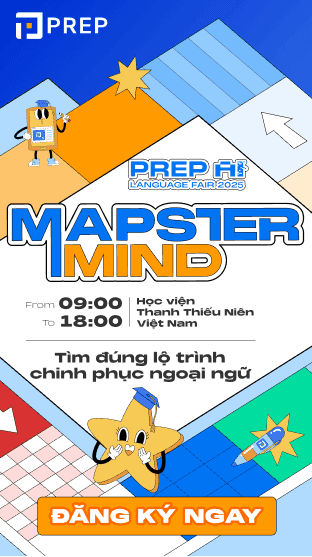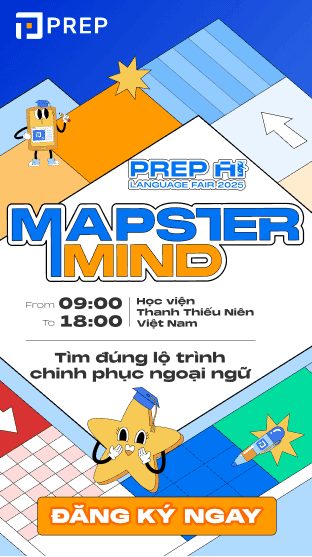Tiếng Anh 12 Unit 6: Artificial Intelligence - Hướng dẫn chi tiết và lời giải đầy đủ
Trong chương trình tiếng Anh 12 unit 6, chúng ta sẽ cùng nhau khám phá một chủ đề vô cùng hiện đại và hấp dẫn: "Artificial Intelligence" (Trí tuệ nhân tạo). Đây là một lĩnh vực không chỉ quan trọng trong đời sống mà còn là nguồn kiến thức ngôn ngữ phong phú, giúp bạn mở rộng vốn từ vựng và nắm vững các cấu trúc ngữ pháp phức tạp.
Bài viết này sẽ là một cẩm nang toàn diện, hướng dẫn bạn soạn bài tiếng Anh 12 unit 6 sách Global Success một cách chi tiết nhất. PREP sẽ cung cấp đầy đủ lời giải, bản dịch, phân tích ngữ pháp, và các bài viết mẫu, đảm bảo bạn có thể tự tin chinh phục mọi phần kiến thức của Unit 6 lớp 12. Cùng bắt đầu nhé!

I. Getting Started (Trang 76 - 77)
Phần mở đầu của tiếng Anh 12 unit 6 đưa chúng ta đến một trung tâm công nghệ cao và làm quen với Jessica, một robot hình người.
1. Task 1
Listen and read.
Bản dịch song song đoạn hội thoại Getting started Unit 6 tiếng Anh 12 như sau:
|
Văn bản gốc |
Bản dịch |
|
Teacher: Hello, class. Please meet Jessica. She’s a human-like robot and will be your guide today. |
Giáo viên: Chào cả lớp. Đây là Jessica, một robot giống người và sẽ là hướng dẫn viên của các em hôm nay. |
|
Jessica: Good morning, everybody. Welcome to the New Tech Centre. |
Jessica: Chào buổi sáng tất cả mọi người. Chào mừng đến với Trung tâm Công nghệ Mới. |
|
Nam: Hi, Jessica. I’m so excited as I’ve never met a talking robot before. Let’s have a photo taken together! |
Nam: Chào Jessica. Mình rất hào hứng vì chưa bao giờ gặp robot biết nói. Chụp ảnh chung đi nhé! |
|
Jessica: OK, I’ll get someone to take a picture of us, but let’s go first to the robot exhibition where you’ll see a collection of human-like robots from around the world. Please follow me. … OK, do you have any questions? |
Jessica: Được rồi, mình sẽ nhờ ai đó chụp ảnh cho tụi mình. Nhưng trước tiên, hãy đến khu triển lãm robot, nơi có rất nhiều robot giống người đến từ khắp nơi trên thế giới. Mời các bạn đi theo mình. … Được rồi, các bạn có câu hỏi nào không? |
|
Mai: They look so real! Can we interact with them? |
Mai: Chúng trông thật quá! Mình có thể tương tác với chúng không? |
|
Jessica: Yes, you can. They’re all capable of answering questions and translating from different languages. Let me get this robot activated so you can talk to him. |
Jessica: Có chứ. Tất cả đều có thể trả lời câu hỏi và dịch từ nhiều ngôn ngữ khác nhau. Để mình bật robot này lên để các bạn nói chuyện nhé. |
|
Mai: Hello, what’s your name? What languages can you speak? Where do you live? |
Mai: Xin chào, bạn tên gì? Bạn có thể nói những ngôn ngữ nào? Bạn sống ở đâu? |
|
Robby: Hello, my name’s Robby. I can speak English, Vietnamese, Chinese, and German. I live in the New Tech Centre. |
Robby: Xin chào, mình tên là Robby. Mình có thể nói tiếng Anh, tiếng Việt, tiếng Trung và tiếng Đức. Mình sống ở Trung tâm Công nghệ Mới. |
|
Mai: Wow! You’re so smart, Robby. |
Mai: Wow! Bạn thông minh thật đấy, Robby. |
|
Nam: Jessica, where shall we go next? |
Nam: Jessica, tiếp theo tụi mình sẽ đi đâu? |
|
Jessica: Next, we’ll visit the Research and Development area. Please follow me. Here scientists and engineers explore and create new AI technologies. AI has many practical applications such as facial recognition and virtual assistants. |
Jessica: Tiếp theo, chúng ta sẽ đến khu Nghiên cứu và Phát triển. Mời các bạn đi theo mình. Ở đây, các nhà khoa học và kỹ sư nghiên cứu và tạo ra các công nghệ trí tuệ nhân tạo mới. AI có nhiều ứng dụng thực tiễn như nhận diện khuôn mặt và trợ lý ảo. |
|
Mai: I noticed a facial recognition screen at the entrance of the centre. |
Mai: Mình có thấy màn hình nhận diện khuôn mặt ở cổng vào trung tâm. |
|
Jessica: That’s right. We have all visitors’ identity checked to improve the centre security. Now, what else would you like to see? |
Jessica: Đúng vậy. Tất cả khách đến đều được kiểm tra danh tính để tăng cường an ninh cho trung tâm. Bây giờ các bạn còn muốn xem gì nữa? |
2. Task 2
Read the conversation again and answer the questions. (Đọc lại hội thoại và trả lời câu hỏi.)
-
Why is Nam excited?
Answer: He is excited because he has never met a talking robot before. (Cậu ấy hào hứng vì chưa bao giờ gặp một robot biết nói trước đây.)
-
What can human-like robots do?
Answer: They are capable of answering questions and translating from different languages. (Chúng có khả năng trả lời câu hỏi và dịch từ nhiều ngôn ngữ khác nhau.)
-
What are some examples of AI applications?
Answer: Some examples are facial recognition and virtual assistants. (Một vài ví dụ là nhận dạng khuôn mặt và các trợ lý ảo.)
-
Where did Mai see a facial recognition screen?
Answer: She saw it at the entrance of the centre. (Cô ấy đã thấy nó ở lối vào của trung tâm.)
3. Task 3
Find words in 1 with the following meanings.
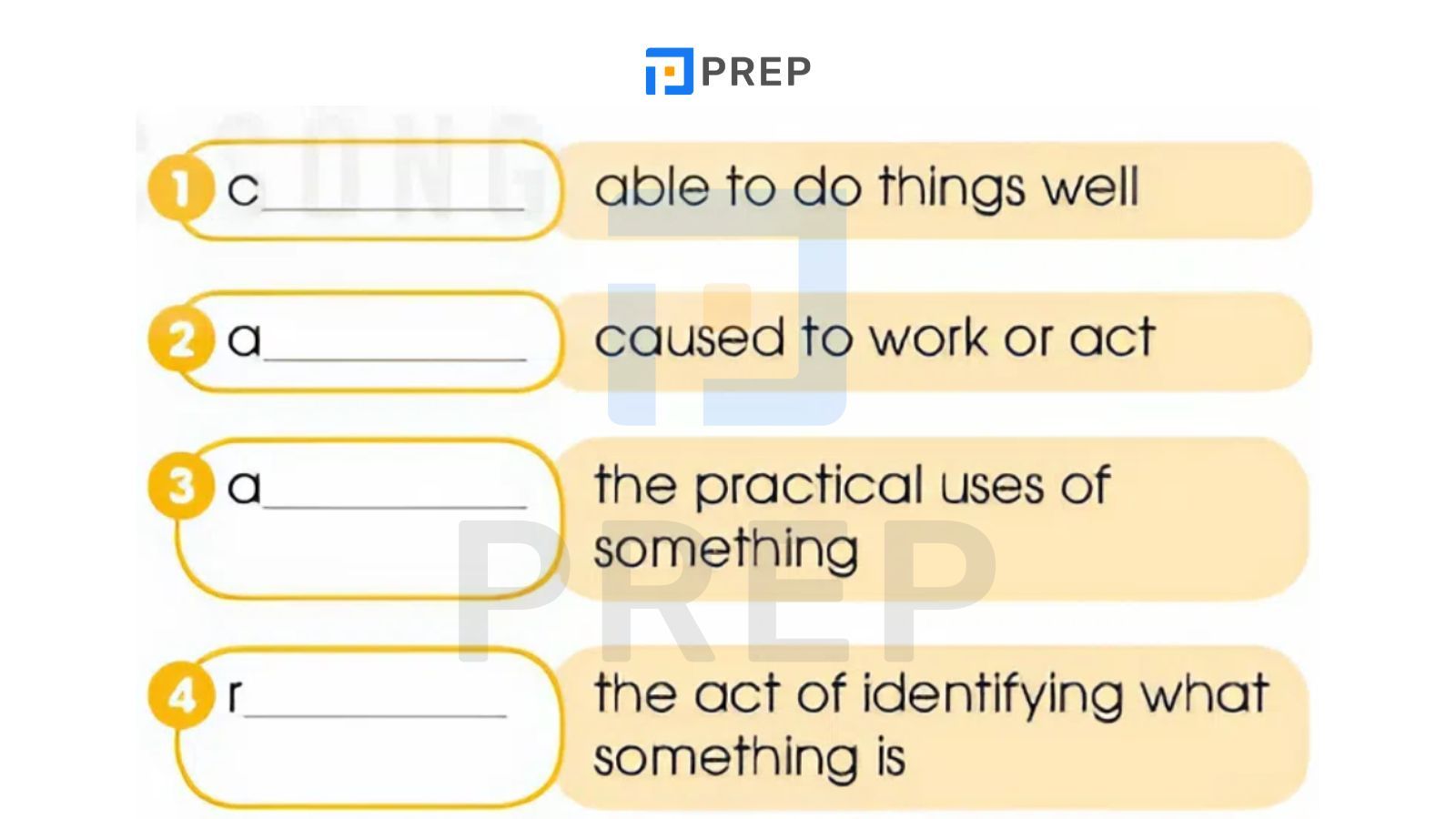
1. capable = able to do things well
Giải thích: Trong đoạn hội thoại, Jessica nói các robot “are all capable of answering questions”, nghĩa là "có khả năng làm tốt điều gì đó".
2. activated = caused to work or act
Giải thích: Jessica nói “Let me get this robot activated”, nghĩa là làm cho robot hoạt động.
3. applications = the practical uses of something
Giải thích: Jessica nói “AI has many practical applications”, tức là “AI có nhiều ứng dụng thực tiễn”.
4. recognition = the act of identifying what something is
Giải thích: Mai và Jessica nói đến “facial recognition”, tức là "nhận diện khuôn mặt", hành động xác định ai đó là ai.
4. Task 4
Complete the sentences with words or a phrase from 1. (Hoàn thành câu với từ hoặc cụm từ trong bài 1.)
-
Let’s have a photo taken together.
-
Let’s get someone to take a picture of us.
-
Let me get this robot activated so you can talk to him.
-
We have all visitors’ identity checked to improve the centre security.
II. Language (Trang 78 - 79)
Phần Language trong Anh 12 unit 6 tập trung vào các yếu tố ngôn ngữ quan trọng: từ đồng âm, từ vựng về khoa học công nghệ, và đặc biệt là cấu trúc thể nhờ vả.
1. Pronunciation - Homophones (Phát âm - Từ đồng âm)
Từ đồng âm là những từ có cách phát âm giống hệt nhau nhưng lại có nghĩa và cách viết hoàn toàn khác nhau.
1.1. Task 1
Listen and repeat the following homophones.
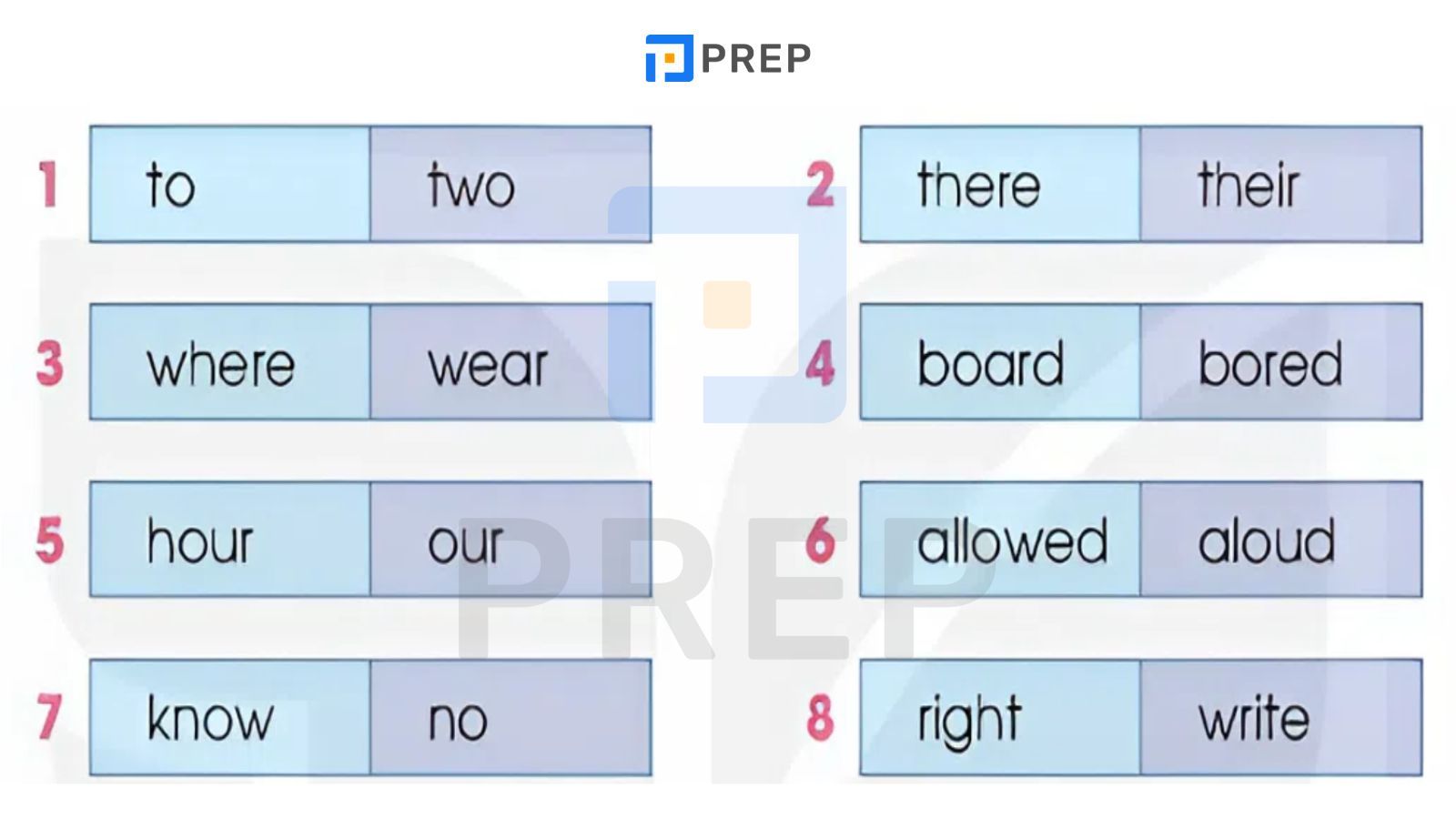
1.2. Task 2
Choose the correct words to complete the sentences. Listen and repeat. Then practise saying the sentences in pairs.
1. There are more than two types of robots.
Giải thích: "Two" là số từ (2), phù hợp với "types of robots". "To" là giới từ, không hợp ngữ cảnh.
2. We want to know where AI technologies are used today.
Giải thích: "Where" dùng để hỏi về nơi chốn. "Wear" là động từ (mặc đồ), không phù hợp ở đây.
3. There have been some worries about AI taking over the world.
Giải thích: "There have been..." là cấu trúc thông dụng để nói rằng có điều gì đó xảy ra. "Their" là tính từ sở hữu (của họ), không phù hợp ở đây.
4. Robots can work for long hours without feeling tired.
Giải thích: "Hours" là danh từ (giờ), hợp với nghĩa "làm việc trong nhiều giờ". "Ours" là tính từ sở hữu (của chúng ta), không đúng ngữ cảnh.
5. We have no idea about the future of AI.
Giải thích: "Have no idea" là cụm từ cố định có nghĩa là "không biết gì". "Know" là động từ, không dùng sau "have".
2. Vocabulary - Science and technology
2.1. Task 1
Match the words with their meanings.
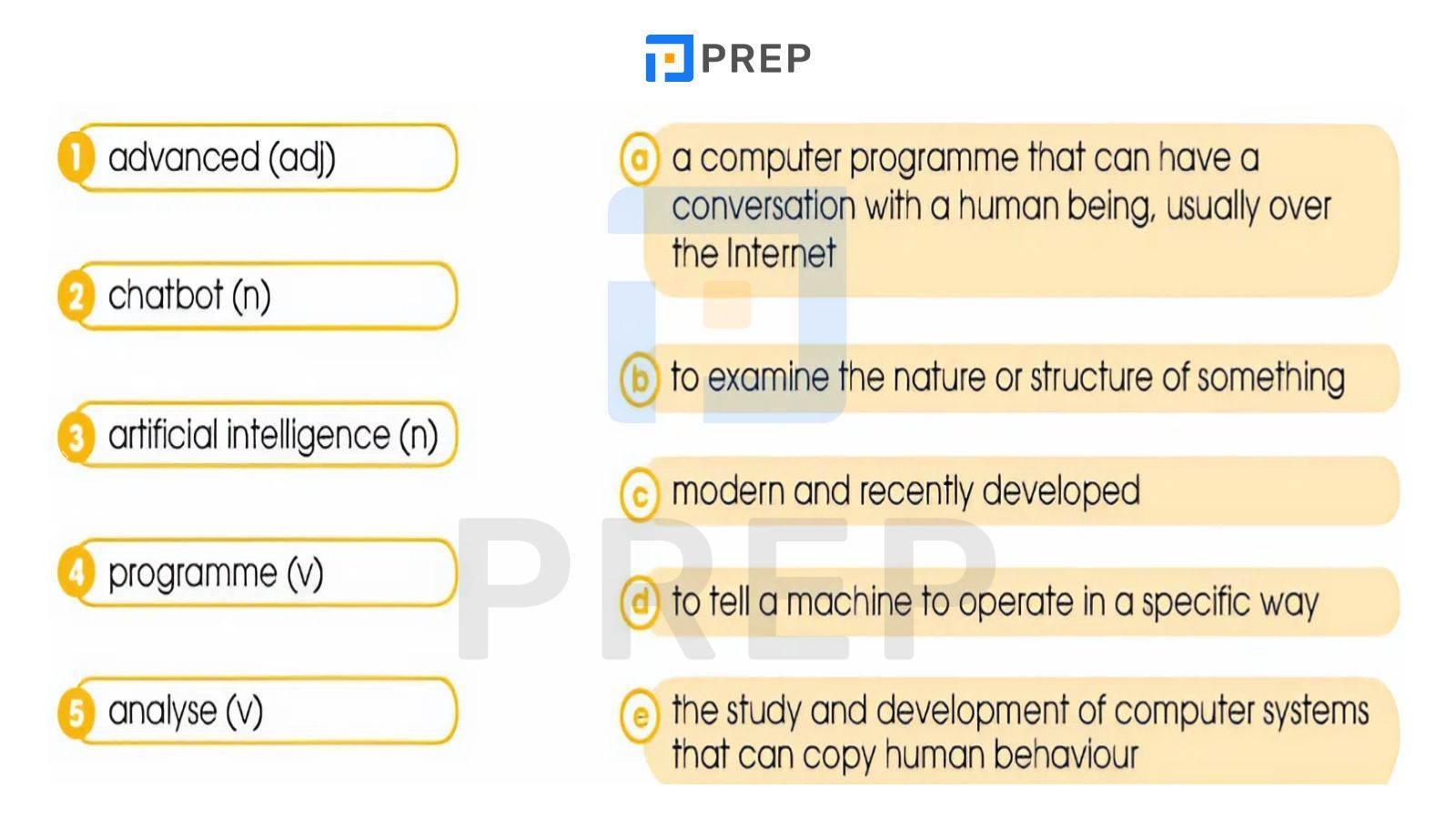
Đáp án:
1. advanced (adj) → c: modern and recently developed
2. chatbot (n) → a: a computer programme that can have a conversation with a human being, usually over the Internet
3. artificial intelligence (n) → e: the study and development of computer systems that can copy human behaviour
4. programme (v) → d: to tell a machine to operate in a specific way
5. analyse (v) → b: to examine the nature or structure of something
Nếu muốn tìm hiểu thêm các từ vựng trong tiếng Anh 12 Unit 6 hãy tham khảo phần IX của bài viết này nhé!
2.2. Task 2
Complete the sentences using the correct forms of the words from 1.
1. Artificial intelligence is now part of our everyday lives.
2. With its human-like appearance and ability to walk and talk, Sophia is considered the most advanced robot in the world.
3. Robots must be programmed to perform human-like activities.
4. This programme uses students’ answers to analyse their language proficiency.
5. Many businesses use chatbots to offer real-time customer support.
3. Grammar - Active and Passive Causatives
Thể nhờ vả (causatives) được sử dụng khi chủ ngữ không tự thực hiện hành động mà sắp xếp hoặc khiến người/vật khác thực hiện nó; đây là một phần kiến thức trọng tâm của tiếng Anh 12 unit 6 sách mới. Chúng ta có hai dạng chính cần nắm vững.
|
Thể nhờ vả |
Công thức |
Ý nghĩa |
|
Chủ động (Active) |
S + have + someone + V-inf S + get + someone + to V-inf |
Nhấn mạnh người thực hiện hành động. (Nhờ/khiến ai đó làm gì) |
|
Bị động (Passive) |
S + have / get + something + V3/ed |
Nhấn mạnh vào hành động hoặc đối tượng bị tác động. (Có cái gì được làm bởi ai đó) |
3.1. Task 1
Rewrite the sentences using active or passive causatives.
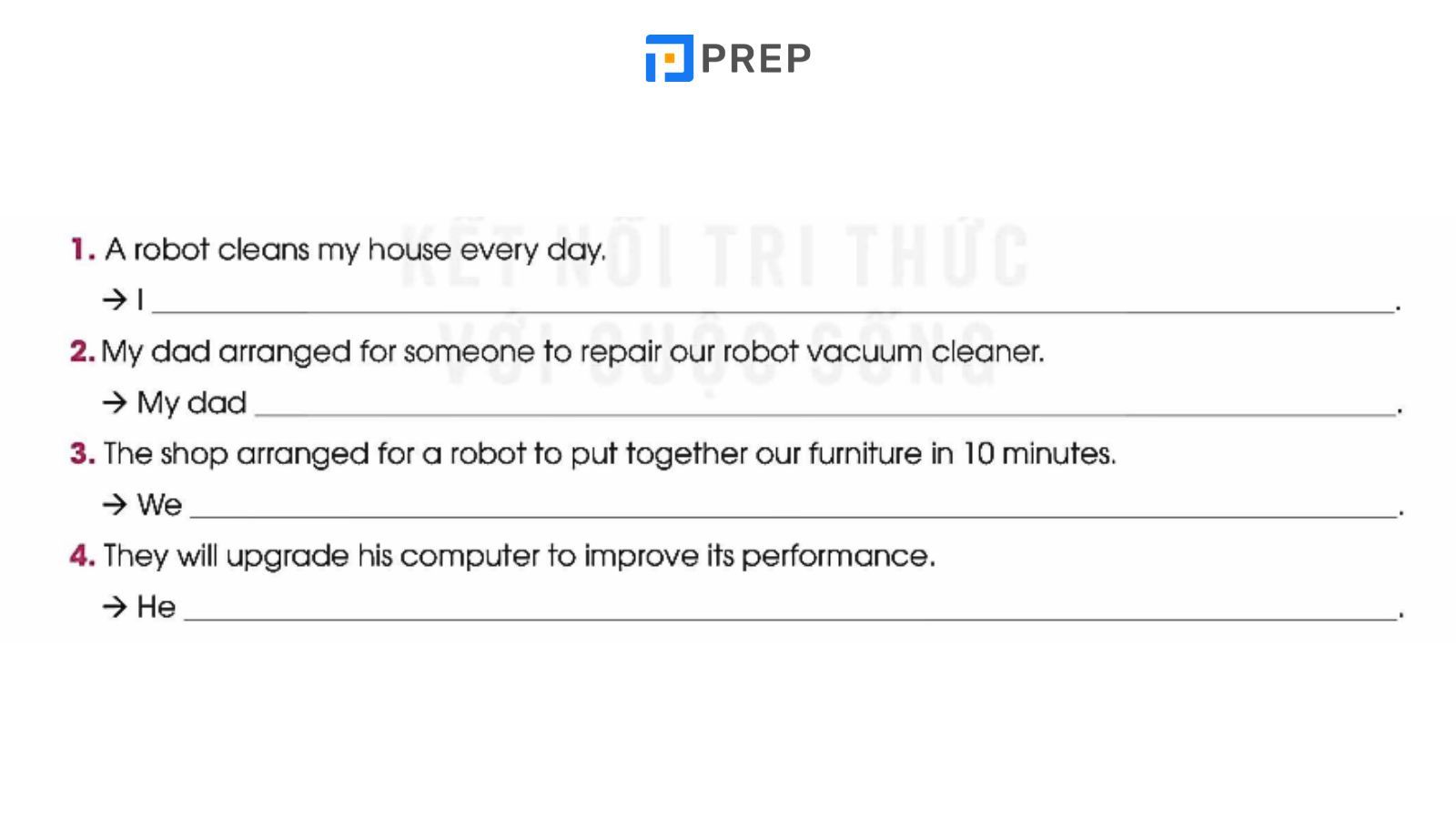
1. I have a robot clean my house every day. (Tôi nhờ một con robot dọn nhà mỗi ngày.)
Giải thích: Hành động 'clean' do 'a robot' thực hiện, nên ta dùng cấu trúc nhờ vả chủ động have someone do something.
2. My dad had/got our robot vacuum cleaner repaired. (Bố tôi đã đem cái máy hút bụi robot đi sửa.)
Giải thích: Câu này không nhấn mạnh "ai" là người sửa, chỉ tập trung vào việc "cái máy hút bụi được sửa". Do đó, ta sử dụng cấu trúc bị động.
3. We had the shop's robot put together our furniture in 10 minutes. / We got the shop's robot to put together our furniture in 10 minutes. (Chúng tôi đã nhờ robot của cửa hàng lắp ráp đồ đạc.)
Giải thích: 'A robot' là đối tượng thực hiện hành động 'put together', vì vậy ta dùng cấu trúc chủ động.
4. They will upgrade his computer to improve its performance.
→ He will have/get his computer upgraded to improve its performance. (Anh ấy sẽ đem máy tính của mình đi nâng cấp.)
Giải thích: Nhấn mạnh vào việc "máy tính được nâng cấp", không quan trọng ai làm, nên dùng cấu trúc bị động.
3.2. Task 2
Work in pairs. Make predictions about applications of robots in the future, using causatives.
Một số câu dự đoán về ứng dụng của robot trong tương lai sử dụng câu sai khiến (causatives):
-
People will have robots cook meals for them. (Mọi người sẽ để robot nấu ăn cho họ.)
-
People will have the house cleaned by robots. (Mọi người sẽ để robot dọn dẹp nhà cửa.)
-
Farmers will have robots harvest the crops. (Nông dân sẽ để robot thu hoạch mùa màng.)
-
Students will have their homework done by robots. (Học sinh sẽ để robot làm bài tập về nhà.)
-
Factories will have robots check the quality of products. (Các nhà máy sẽ để robot kiểm tra chất lượng sản phẩm.)
III. Reading (Trang 80 - 81)
Bài đọc trong soạn Anh 12 Unit 6 giới thiệu về các ứng dụng thực tiễn của Trí tuệ nhân tạo trong lĩnh vực giáo dục, một chủ đề rất gần gũi và hữu ích.
Xem chi tiết bài dịch và lời giải chi tiết tại tiếng Anh 12 Unit 6 Reading.
IV. Speaking (Trang 82)
Kỹ năng nói là một phần không thể thiếu để bạn có thể thực sự làm chủ ngôn ngữ. Trong phần này của Anh 12 unit 6, bạn sẽ được luyện tập thảo luận về các ứng dụng của AI trong giáo dục, một chủ đề rất thực tế và đầy cảm hứng.
1. Task 1
Match the AI applications (1-5) with their purposes in learning (a-f). (Nối các ứng dụng AI với mục đích của chúng trong học tập.)
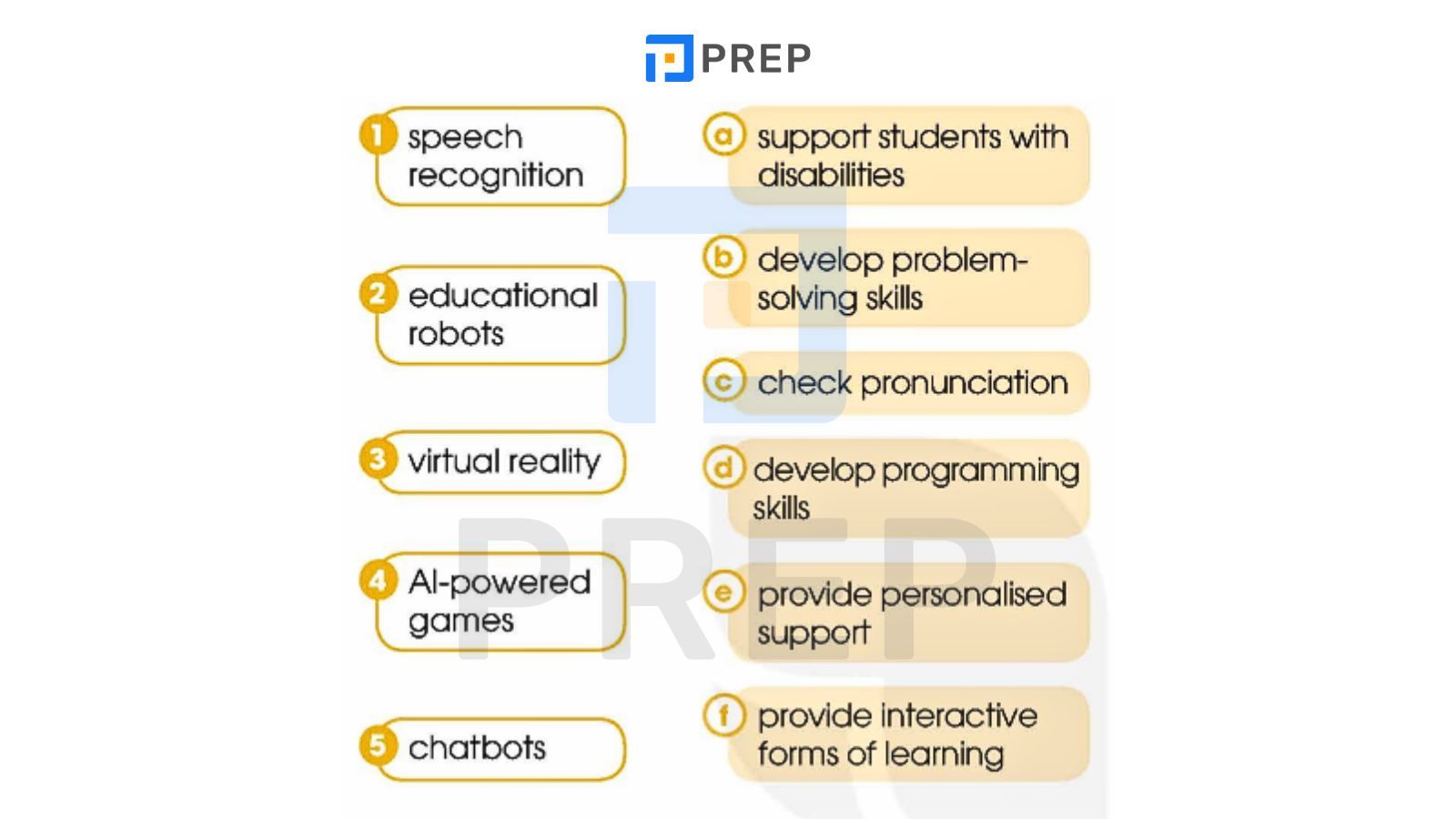
Đáp án gợi ý:
-
1 - a, c, e (speech recognition - nhận dạng giọng nói: hỗ trợ học sinh khuyết tật, kiểm tra phát âm, cung cấp hỗ trợ cá nhân)
-
2 - a, d, f (educational robots - robot giáo dục: hỗ trợ học sinh khuyết tật, phát triển kỹ năng lập trình, cung cấp các hình thức học tập tương tác)
-
3 - a, f (virtual reality - thực tế ảo: hỗ trợ học sinh khuyết tật, cung cấp các hình thức học tập tương tác)
-
4 - b, f (AI-powered games - phát triển kỹ năng giải quyết vấn đề, cung cấp các hình thức học tập tương tác)
-
5 - e, f (chatbots - robot trò chuyện: cung cấp hỗ trợ cá nhân, cung cấp các hình thức học tập tương tác)
2. Task 2
Work in groups. Discuss the questions. (Làm việc nhóm. Thảo luận các câu hỏi.)
Để cuộc thảo luận của bạn hiệu quả, hãy thử xây dựng ý tưởng dựa trên các gợi ý sau:
|
How can each application in 1 be used in education? (Mỗi ứng dụng có thể được sử dụng trong giáo dục như thế nào?) |
|
|
What are the advantages and disadvantages of each application? (Ưu và nhược điểm của mỗi ứng dụng là gì?) |
Ví dụ với Chatbots:
|
3. Task 3
Prepare a summary of your discussion and report it to the whole class. (Chuẩn bị một bản tóm tắt và báo cáo trước cả lớp.)
Đoạn tóm tắt mẫu: "Today, we discussed how different AI applications can be used in education. For example, speech recognition helps students practise pronunciation and supports students with disabilities. Educational robots can develop problem-solving and programming skills. Virtual reality brings interactive and engaging experiences to the classroom. AI-powered games make learning more fun and motivating, while chatbots provide 24/7 support for learners.
However, there are also disadvantages. Some tools are expensive or require special devices. Others, like chatbots, cannot replace human interaction or answer complex questions. We need to use these tools wisely to get the best results in learning.."
V. Listening
Phần nghe yêu cầu sự tập trung cao độ để bạn có thể nắm bắt thông tin về cách vận hành một robot tại nhà. Để hỗ trợ bạn học tốt nhất, dưới đây là lời thoại đầy đủ (transcript) và lời giải chi tiết.
1. Task 1
Work in pairs. Discuss the following questions.
1. Would you like to have a robot to help you in your daily life?
Yes, I would love to have a robot to help me in my daily life. It would save me time and make my routine easier.
(Dịch: Có, mình rất muốn có một con robot để giúp mình trong cuộc sống hàng ngày. Nó sẽ giúp tiết kiệm thời gian và làm cho mọi việc đơn giản hơn.)
2. What would you like it to do for you?
I would like the robot to help me with household chores like cleaning, washing dishes, and doing laundry. I also want it to remind me of important tasks and help me with my homework.
(Dịch: Mình muốn robot giúp làm việc nhà như dọn dẹp, rửa chén, giặt đồ. Ngoài ra, mình cũng muốn nó nhắc nhở mình những việc quan trọng và giúp làm bài tập về nhà.)
2. Task 2
Listen to the first part of a conversation between Nam and an AI expert. Decide whether the following statements are true (T) or false (F).
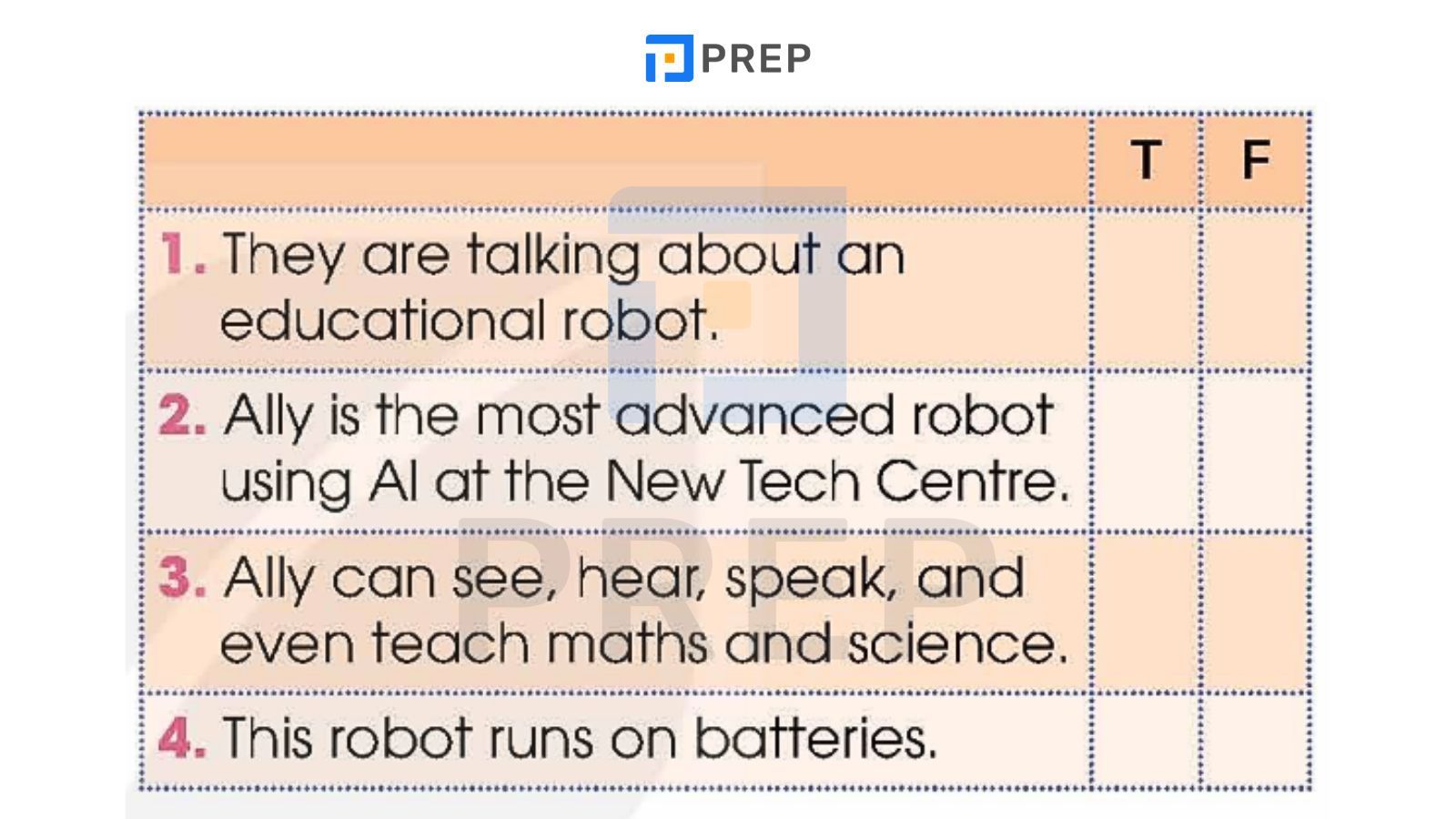
-
They are talking about an educational robot. → F (Họ đang nói về một robot gia đình - home robot).
-
Ally is the most advanced robot using AI at the New Tech Centre. → T (Cô Stewart nói: “It’s the most advanced home robot using artificial intelligence to perform tasks.”)
-
Ally can see, hear, speak, and even teach maths and science. → T (Cô Stewart nói rõ rằng Ally có thể nhìn, nghe, nói và thậm chí dạy Toán và Khoa học.)
-
This robot runs on batteries. → F (Trong bài nghe có đoạn “It uses solar energy” - Nó sử dụng năng lượng mặt trời)
Audio Transcript:
Nam: Excuse me, Ms Stewart. I'd like to know more about the home robots at the New Tech Centre.
Ms Stewart: No problem, Nam. I'll introduce you to Ally. It's the most advanced home robot using artificial intelligence to perform tasks.
Nam: So what can it do?
Ms Stewart: Well, it can see, hear, speak, and even interact with you. It understands several languages and can even teach you maths and science.
Nam: Wow, that's amazing. Does it run on batteries?
Ms Stewart: No, it's eco-friendly. It uses solar energy.
Bản dịch:
Nam: Xin lỗi cô Stewart, em muốn biết thêm về những robot dùng trong gia đình ở Trung tâm Công nghệ Mới.
Cô Stewart: Không vấn đề gì đâu, Nam. Cô sẽ giới thiệu em với Ally. Đó là robot gia đình tiên tiến nhất, sử dụng trí tuệ nhân tạo để thực hiện các công việc.
Nam: Vậy nó có thể làm được gì ạ?
Cô Stewart: À, nó có thể nhìn, nghe, nói và thậm chí tương tác với em. Nó hiểu được nhiều ngôn ngữ và còn có thể dạy em môn Toán và Khoa học nữa.
Nam: Wow, tuyệt thật đấy. Nó chạy bằng pin phải không ạ?
Cô Stewart: Không, nó thân thiện với môi trường. Nó sử dụng năng lượng mặt trời.
3. Task 3
Listen to the second part of the conversation and complete each gap in the diagram with NO MORE THAN TWO WORDS.
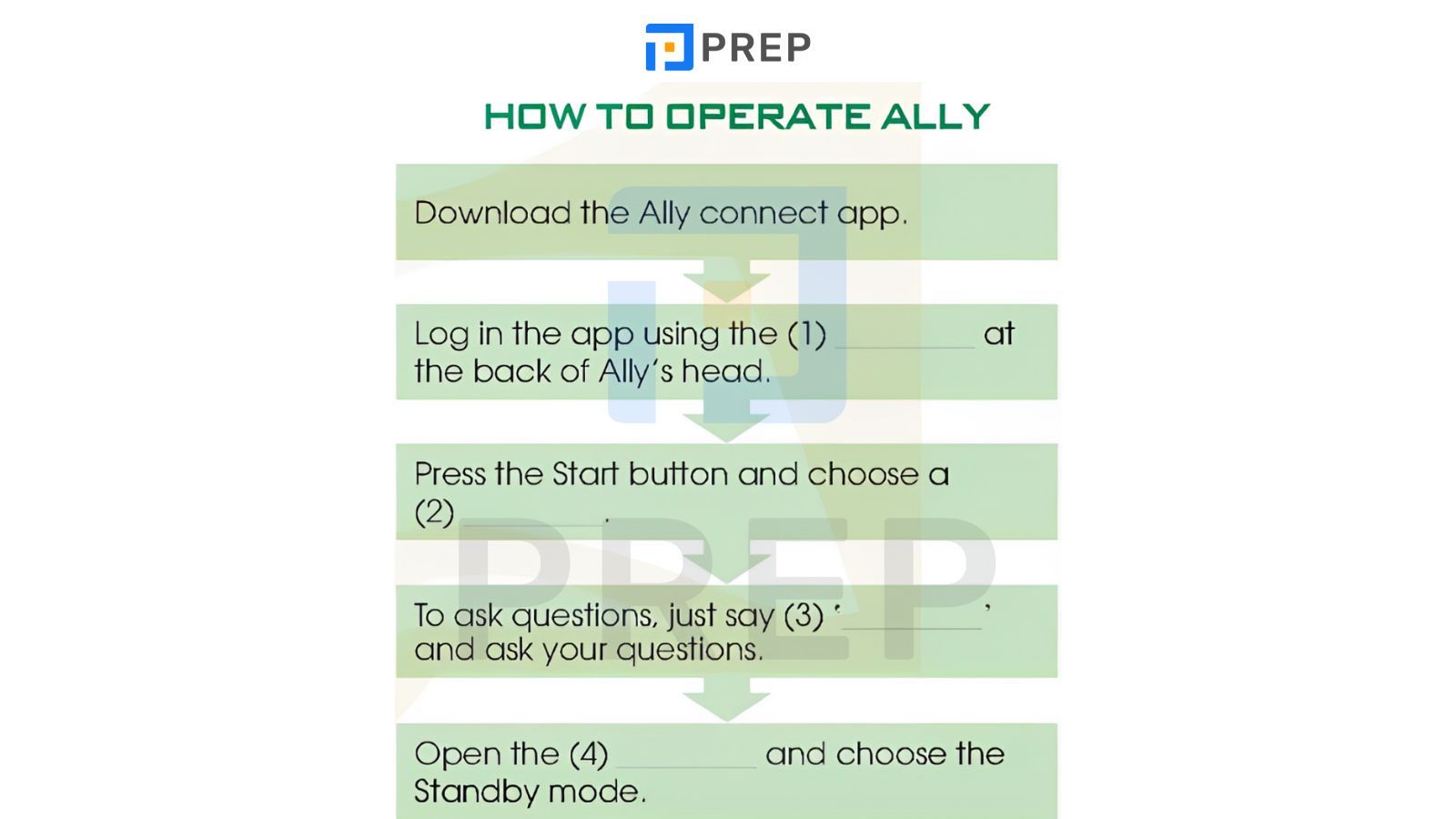
1. Serial numbers
2. Function
3. Hey Ally
4. App
Audio Transcript:
Nam: How is Ally controlled?
Ms Stewart: Well, it's programmed in advance so you can control it by using the Ally connect app, but you need to download it first to your phone.
Nam: OK, sounds easy. What's the next step?
Ms Stewart: Log in to the app using the serial number printed at its back head. Then you press the Start button and choose the function you want it to perform.
Nam: Great! I can remotely move Ally through the app from anywhere in the world!
Ms Stewart: That's right. You can also control Ally by voice commands, such as 'Hello Ally. Move forward."
Nam: Is it capable of answering questions?
Ms Stewart: Yes, of course. Just say 'Hey Ally' followed by a question and it'll give you the answer.
Nam: When Ally finishes a task, what should I do?
Ms Stewart: A notification will be sent to your phone when Ally completes it. Open the app, choose Standby mode and Ally will get back to its charging station.
Nam: Great! I hope I can save enough money to buy this amazing robot!
Bản dịch:
Nam: Ally được điều khiển như thế nào ạ?
Cô Stewart: À, nó được lập trình sẵn nên em có thể điều khiển bằng ứng dụng Ally Connect, nhưng trước tiên em cần tải ứng dụng đó về điện thoại.
Nam: Vâng, nghe có vẻ dễ. Bước tiếp theo là gì ạ?
Cô Stewart: Đăng nhập vào ứng dụng bằng số sê-ri được in phía sau đầu của Ally. Sau đó em nhấn nút “Start” và chọn chức năng mà em muốn nó thực hiện.
Nam: Tuyệt quá! Vậy là em có thể điều khiển Ally từ xa qua ứng dụng, dù ở bất cứ đâu trên thế giới!
Cô Stewart: Đúng rồi. Em cũng có thể điều khiển Ally bằng giọng nói, ví dụ như nói: “Hello Ally. Move forward.”
Nam: Nó có thể trả lời câu hỏi không ạ?
Cô Stewart: Có chứ. Em chỉ cần nói “Hey Ally” rồi đọc câu hỏi, và nó sẽ trả lời cho em.
Nam: Khi Ally hoàn thành một nhiệm vụ, em cần làm gì tiếp theo?
Cô Stewart: Một thông báo sẽ được gửi về điện thoại em khi Ally hoàn thành xong. Em chỉ cần mở ứng dụng, chọn chế độ Standby, và Ally sẽ tự động quay về trạm sạc.
Nam: Tuyệt vời! Em hy vọng có thể tiết kiệm đủ tiền để mua con robot tuyệt vời này!
4. Task 4
Work in pairs. Discuss the following questions. Do you want to have the same type of robot? Why/Why not?
Gợi ý câu trả lời 1 (Yes):
Yes, I do. I would like to have the same type of robot like Ally because it is very smart and useful. It can help me with my homework, teach me science and maths, and even respond to voice commands. It is also eco-friendly because it uses solar energy.
(Dịch: Có, mình muốn có cùng loại robot như Ally vì nó rất thông minh và hữu ích. Nó có thể giúp mình làm bài tập, dạy mình môn khoa học và toán, và thậm chí phản hồi bằng giọng nói. Nó còn thân thiện với môi trường vì sử dụng năng lượng mặt trời.)
Gợi ý câu trả lời 2 (No):
No, I don’t. I would prefer to have a different type of robot. Instead of a home robot like Ally, I want an educational robot that can help me improve my programming and problem-solving skills. I think that would be more helpful for my future.
(Dịch: Không, mình muốn một loại robot khác. Thay vì robot gia đình như Ally, mình muốn có một robot giáo dục giúp mình cải thiện kỹ năng lập trình và giải quyết vấn đề. Mình nghĩ điều đó sẽ hữu ích hơn cho tương lai.)
VI. Writing (Trang 83)
Kỹ năng viết trong tiếng Anh 12 unit 6 yêu cầu bạn phải soạn một bài luận khoảng 180-200 từ về những ưu và nhược điểm của robot gia đình, một dạng bài rất phổ biến trong các kỳ thi.
1. Task 1
Work in pairs. Read the notes and decide which are advantages (+) or disadvantages (-) of home robots. Then add the sentences (A-D) in the box to support each advantage or disadvantage.
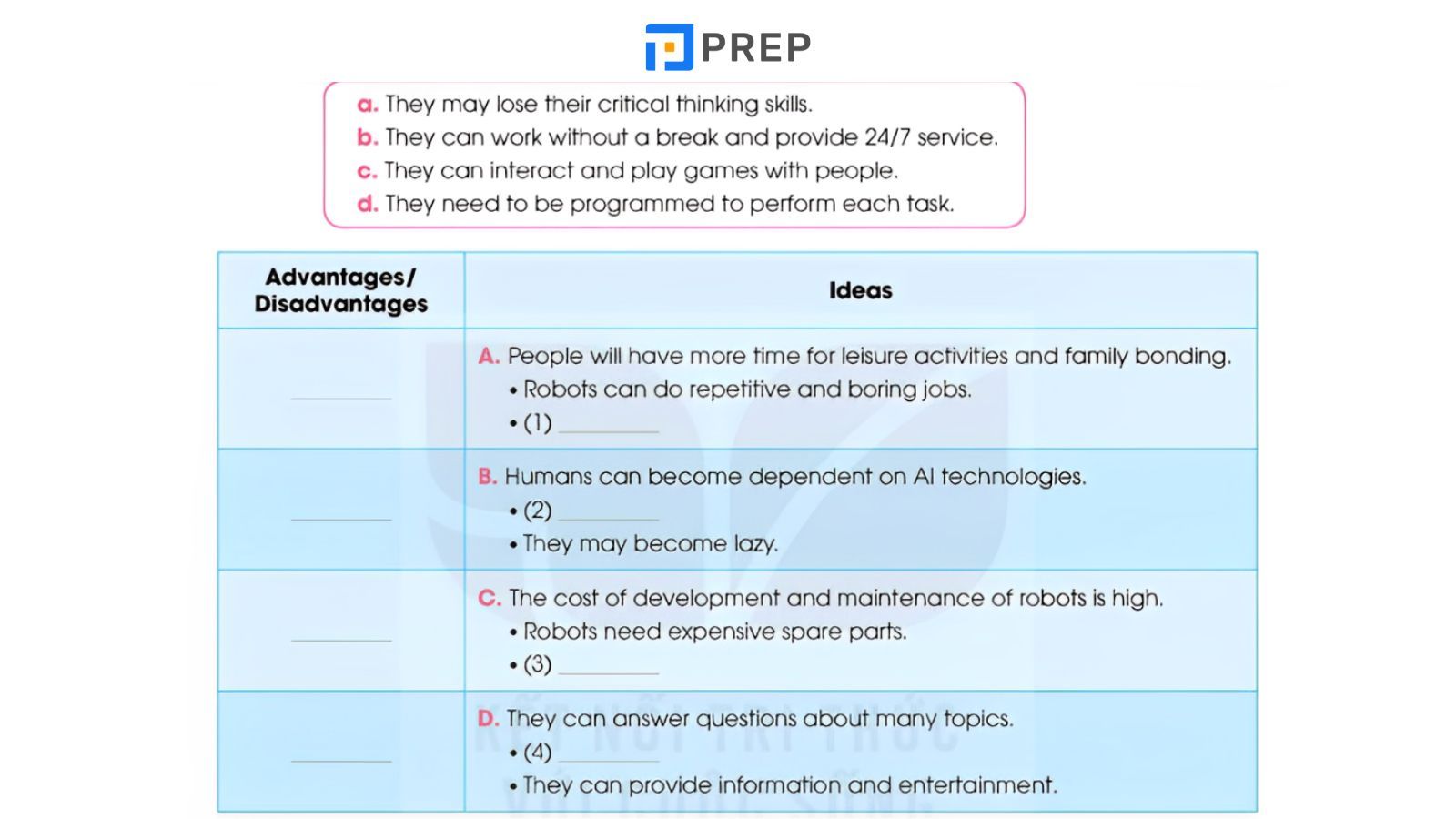
|
Advantages/Disadvantages |
Ideas |
|
+ |
People will have more time for leisure activities and family bonding.
|
|
− |
Humans can become dependent on AI technologies.
|
|
− |
The cost of development and maintenance of robots is high.
|
|
+ |
They can answer questions about many topics.
|
2. Task 2
Write an essay (180-200 words) about the advantages and disadvantages of home robots, using the ideas in 1 and the suggested outline below.
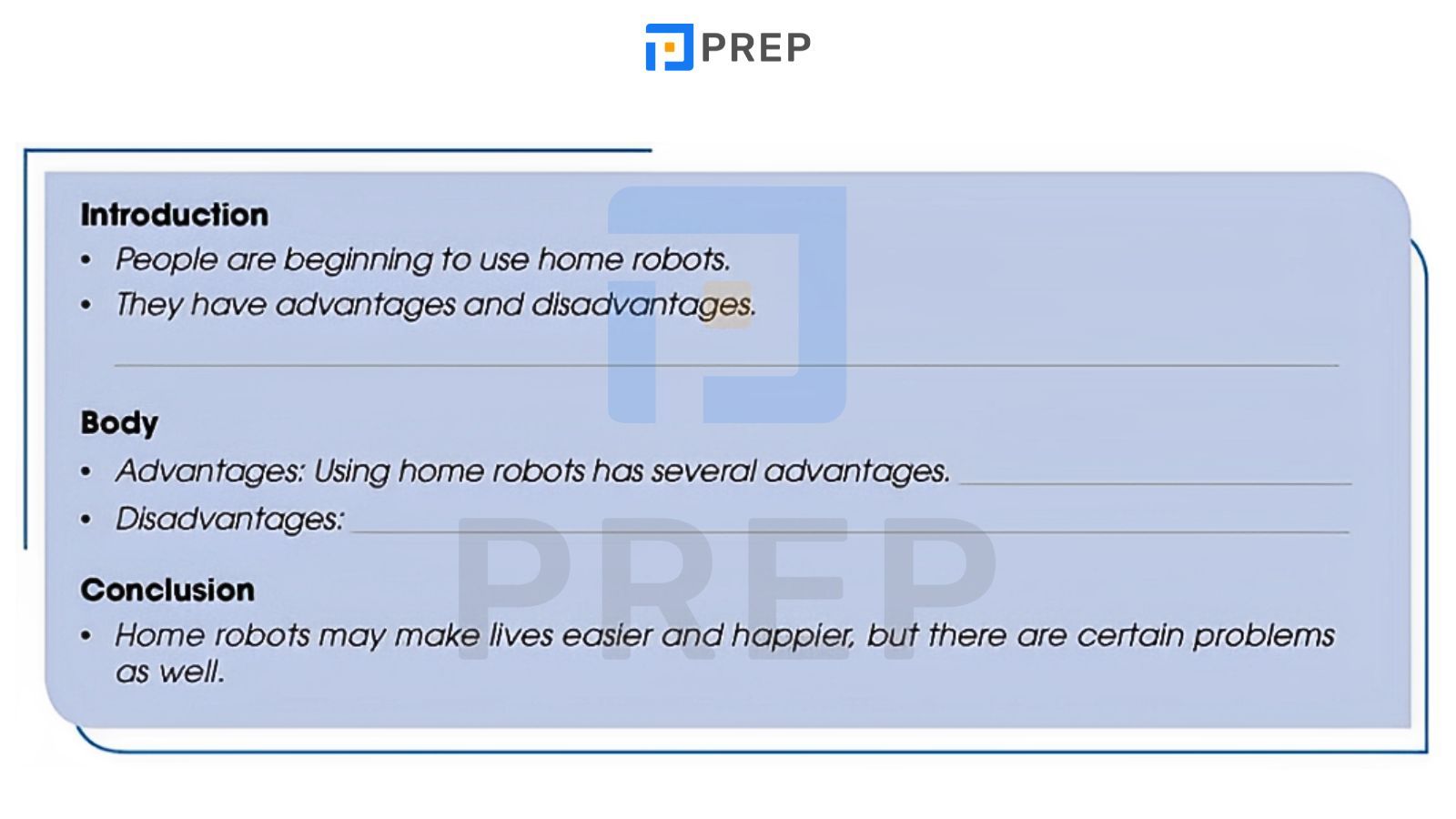
Bài viết mẫu:
The rise of home robots is transforming our daily lives, promising a future of convenience and efficiency. While these intelligent machines offer numerous benefits, they also present considerable drawbacks that need careful consideration. This essay will explore both the advantages and disadvantages of using home robots.
Using home robots has several advantages. First, they can do repetitive and boring chores such as cleaning, washing dishes, and cooking. This gives people more time for leisure or family. Second, robots can work nonstop without taking breaks, offering support at any time. They can also assist elderly people or those with disabilities, making their lives easier and safer.
However, there are also disadvantages. One problem is that people may become too dependent on robots, which could reduce their critical thinking and problem-solving skills. Another issue is the high cost of buying, repairing, and maintaining these machines. Not everyone can afford such advanced technology. In addition, as robots take over some household jobs, there may be fewer opportunities for human workers in certain fields.
In conclusion, home robots may make lives easier and happier, but there are certain problems as well. We need to enjoy the benefits of home robots while being aware of their possible negative effects.
VII. Communication and Culture / CLIL (Trang 84, 85)
Phần này giúp bạn mở rộng kiến thức văn hóa về sự phát triển của robot và cách sử dụng tiếng Anh tự nhiên trong các tình huống giao tiếp hàng ngày.
1. Everyday English - Getting attention and interrupting
1.1. Task 1
Listen and complete the conversations with the expressions in the box. Then practise them in pairs.
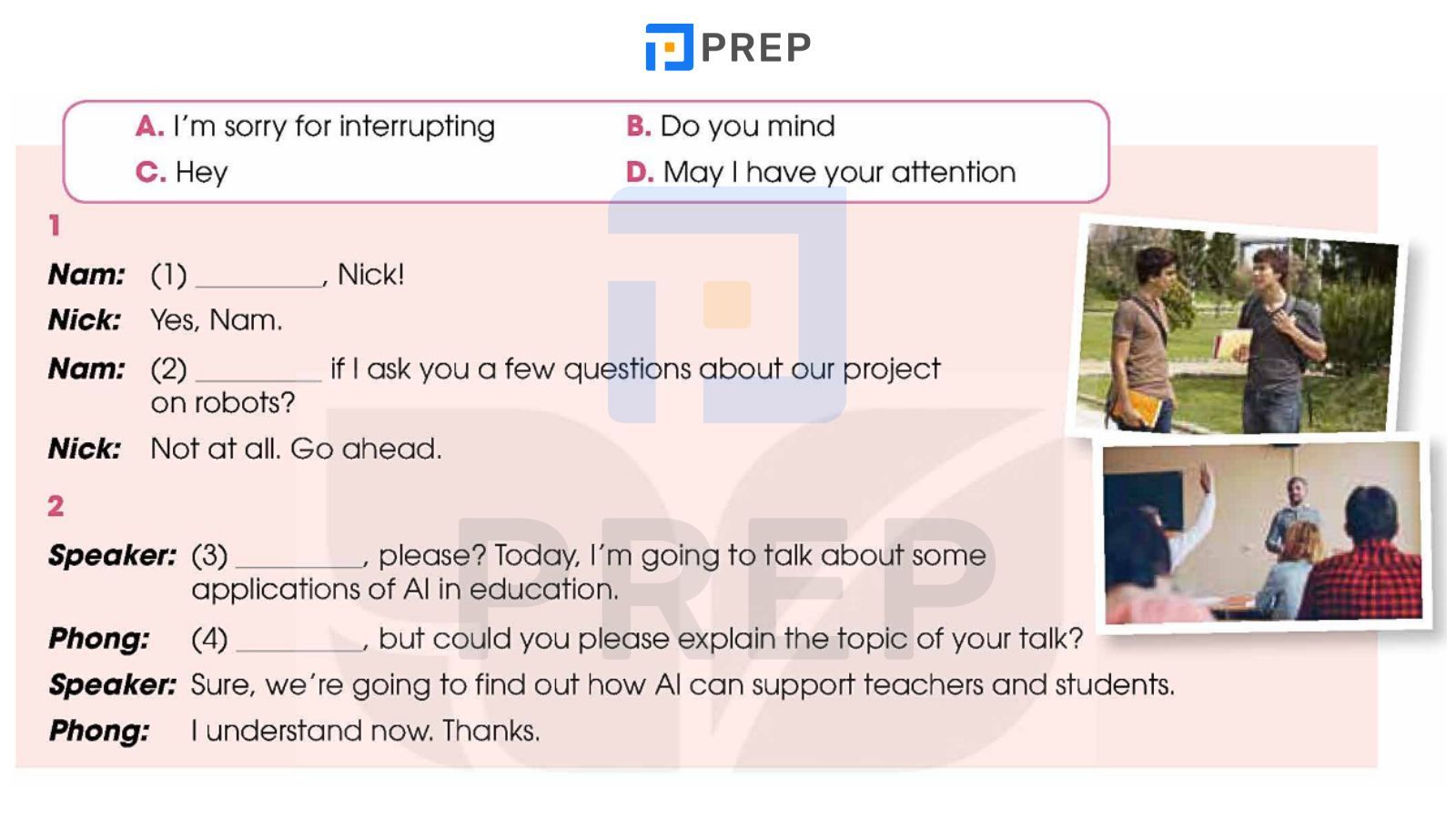
Đáp án:
1.C
2. B
3. D
4. A
1.2. Task 2
Work in pairs. Use the models in 1 to make similar conversations for these situations. One of you is A, the other is B. Use the expressions below to help you.
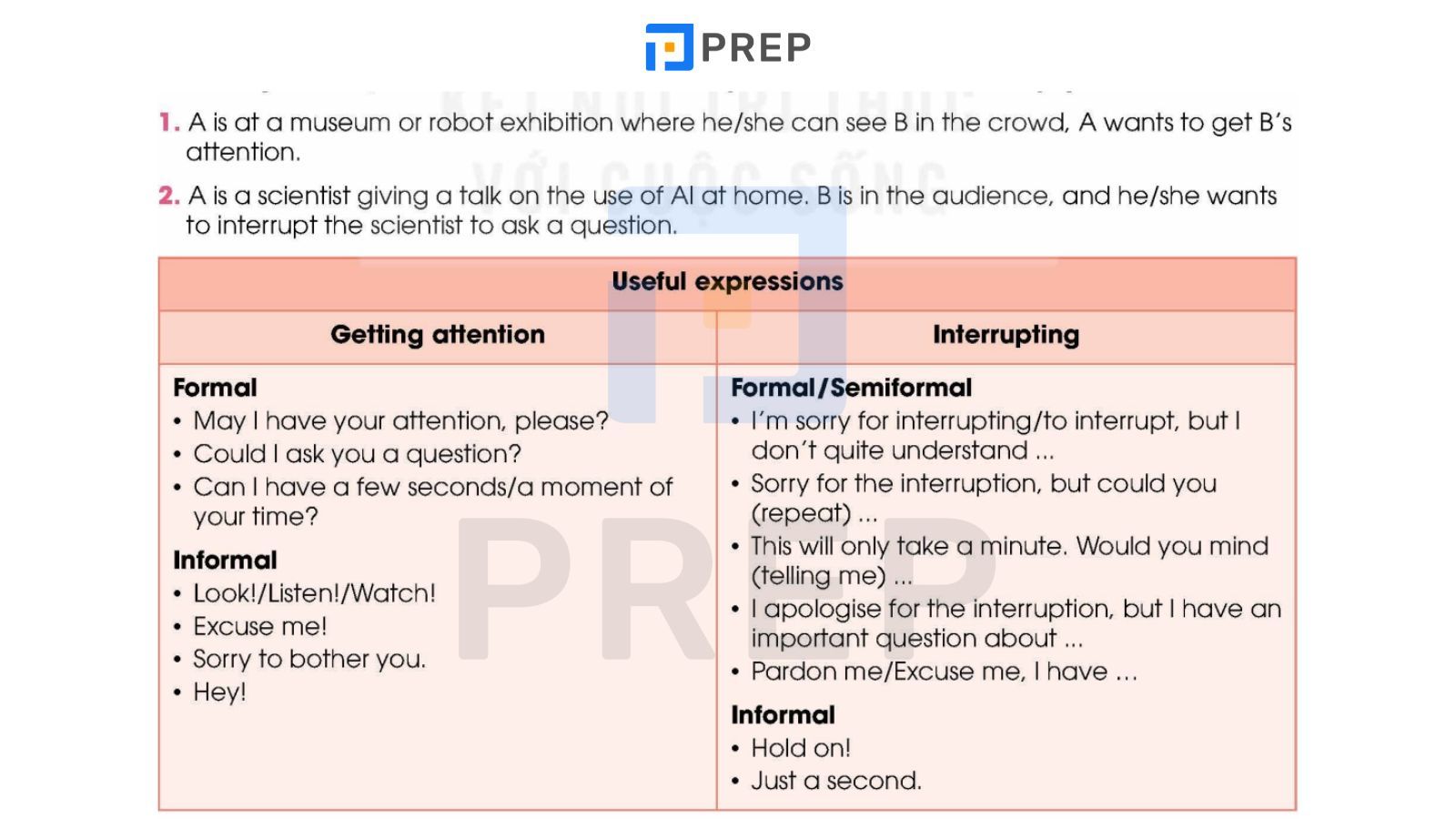
Tình huống 1: A is at a museum or robot exhibition where he/she can see B in the crowd. A wants to get B’s attention.
A: Hey, Anna!
B: Oh, hi! I didn’t see you there.
A: May I have your attention for a moment?
B: Sure. What’s up?
A: I’d love to hear your thoughts on the new robot display. Isn’t it impressive?
Tình huống 2: A is a scientist giving a talk on the use of AI at home. B is in the audience, and he/she wants to interrupt the scientist to ask a question.
B: Excuse me, Dr. Lee. I’m sorry for interrupting, but I have an important question.
A (Dr. Lee): Yes, go ahead.
B: Could you please explain how AI can support elderly people at home?
A: That’s a great question. AI home robots can remind them to take medicine, monitor their health, and even alert family members if something goes wrong.
2. CLIL - The evolution of robots
2.1. Task 1
Read the text and complete the timeline showing the evolution of robots.
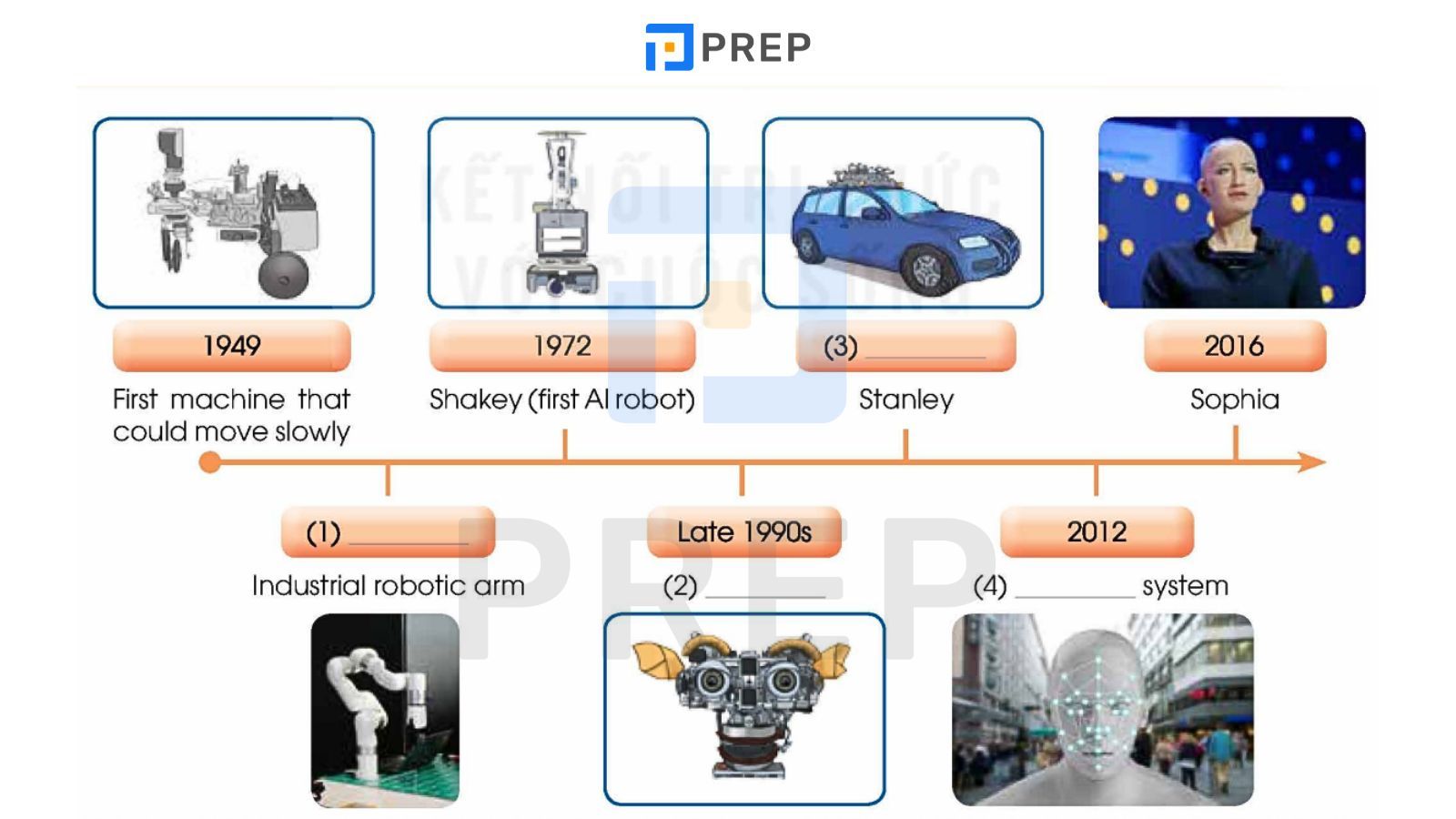
1. 1959
➨ Giải thích: Năm 1959 là thời điểm robot công nghiệp đầu tiên (industrial robotic arm) được lắp đặt trong nhà máy General Motors (10 năm sau 1949).
2. Kismet
➨ Giải thích: Cuối những năm 1990, robot đầu có cảm xúc Kismet được tạo ra.
3. 2005
➨ Giải thích: Xe tự lái Stanley được ra mắt vào năm 2005.
4. Visual recognition
➨ Giải thích: Năm 2012, Geoffrey Hinton và nhóm của ông tạo ra hệ thống nhận diện khuôn mặt đầu tiên.
Bản dịch bài đọc phần CLIL tiếng Anh 12 mới Unit 6:
Từ “robot” lần đầu tiên được sử dụng vào năm 1920. Nó bắt nguồn từ từ “robota” trong tiếng Séc, có nghĩa là “lao động cưỡng bức”, được dùng trong một vở kịch của Karel Čapek để miêu tả những con người nhân tạo.
Năm 1949, nhà phát minh người Anh William Grey Walter đã giới thiệu chiếc máy đầu tiên có thể di chuyển chậm khi phản ứng với ánh sáng. Mười năm sau, cánh tay robot công nghiệp đầu tiên được lắp đặt tại một nhà máy ô tô của General Motors ở Mỹ. Những robot như vậy chủ yếu được dùng trong ngành sản xuất ô tô và máy tính.
Robot đầu tiên sử dụng trí tuệ nhân tạo (AI) được gọi là Shakey. Nó được phát triển tại Viện Nghiên cứu Stanford từ năm 1966 đến 1972. Shakey có thể quan sát môi trường xung quanh, lập kế hoạch và tự tìm đường đi qua phòng hoặc đẩy một cái hộp dọc theo sàn nhà. Hai mươi năm sau, một robot đi bộ tên là Dante, có khả năng leo dốc cao, đã được chế tạo để đi vào các miệng núi lửa đang hoạt động.
Cuối những năm 1990 đánh dấu một cột mốc quan trọng trong lịch sử robot với sự ra đời của Kismet, một robot đầu có thể thể hiện và phản ứng với cảm xúc.
Từ đầu thế kỷ 21, ngày càng có nhiều robot được tạo ra để cải thiện cuộc sống. Xe tự lái đầu tiên ra mắt vào ngày 8 tháng 10 năm 2005, khi một chiếc Volkswagen Touareg tên là Stanley giành chiến thắng trong một cuộc thi đua ở sa mạc.
Năm 2012, chuyên gia AI Geoffrey Hinton và nhóm của ông đã tạo ra hệ thống nhận diện khuôn mặt chính xác đầu tiên.
Năm 2016, Sophia, một robot hình người, được giới thiệu. Sophia có thể bắt chước cử chỉ và biểu cảm khuôn mặt của con người, trả lời câu hỏi và trò chuyện đơn giản.
Trong tương lai, chúng ta có thể sẽ thấy nhiều robot và ứng dụng AI hơn nữa. Dù chúng ta có chấp nhận hay không, AI vẫn sẽ đóng vai trò quan trọng trong mọi mặt của cuộc sống.
2. Task 2
Work in pairs. Discuss the following questions. What types of AI are widely used in Viet Nam? How do you think robots and AI will develop in Viet Nam in the future?
Câu hỏi 1: What types of AI are widely used in Viet Nam?
Gợi ý trả lời: In Viet Nam, AI is widely used in areas such as face recognition at banks and offices, smart traffic systems, voice assistants on mobile phones, and customer service chatbots in online shopping.
(Dịch: Ở Việt Nam, AI được sử dụng phổ biến trong các lĩnh vực như nhận diện khuôn mặt tại ngân hàng và văn phòng, hệ thống giao thông thông minh, trợ lý giọng nói trên điện thoại, và chatbot chăm sóc khách hàng trong mua sắm trực tuyến.)
Câu hỏi 2: How do you think robots and AI will develop in Viet Nam in the future?
Gợi ý trả lời: In the future, robots and AI in Viet Nam will become more advanced. They may be used more in healthcare to support doctors and patients, in education to help students study at home, and in factories to improve productivity.
(Dịch: Trong tương lai, robot và AI ở Việt Nam sẽ phát triển hơn. Chúng có thể được sử dụng nhiều hơn trong y tế để hỗ trợ bác sĩ và bệnh nhân, trong giáo dục để giúp học sinh học tại nhà, và trong nhà máy để tăng năng suất.)
VIII. Looking Back (Trang 86)
Đây là phần cuối cùng của tiếng Anh 12 unit 6, giúp bạn ôn tập lại toàn bộ kiến thức.
1. Pronunciation
Listen and underline the homophone of the word in bold in each sentence. Then practise saying the sentences in pairs.
1. Allowed - aloud
2. Bored - board
3. Where - wear
4. Know - no
2. Vocabulary
Complete the sentences using the correct forms of the words in the box.
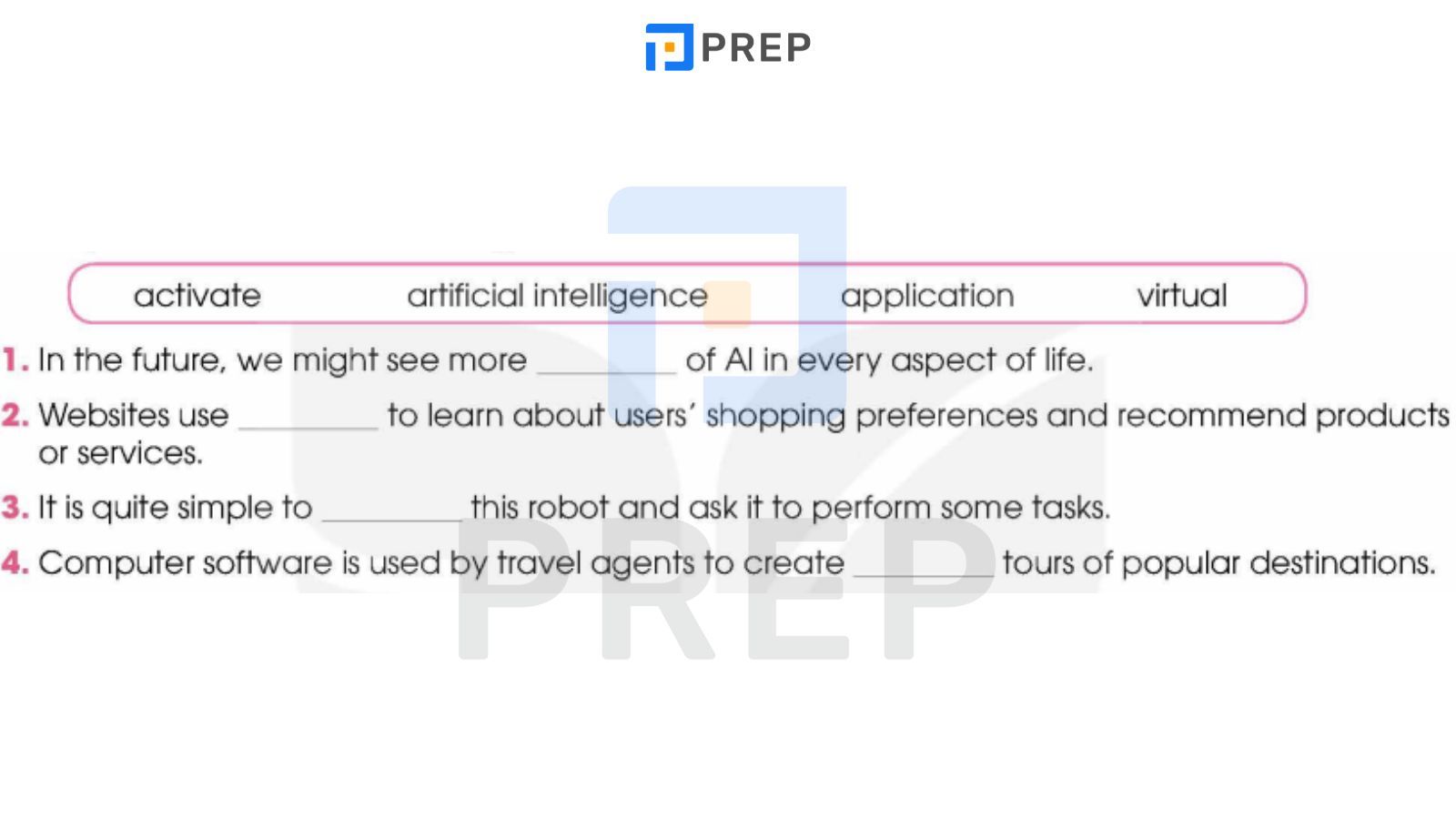
1. In the future, we might see more applications of AI in every aspect of life.
2. Websites use artificial intelligence to learn about users' shopping preferences...
3. It is quite simple to activate this robot and ask it to perform some tasks.
4. Computer software is used by travel agents to create virtual tours of popular destinations.
3. Grammar
Choose the option A, B, C, or D that is closest in meaning to each of the given sentences.
1. A. I am going to have my broken laptop fixed by the computer shop. (Tôi sẽ đem cái laptop hỏng của mình đi sửa ở cửa hàng máy tính.)
2. C. We had our home robot walk and feed our pets when we were away. (Chúng tôi đã nhờ robot cho thú cưng đi dạo và cho ăn khi chúng tôi đi vắng.)
3. D. She got a mechanic to install a smart lock on her front door yesterday. (Hôm qua cô ấy nhờ thợ sửa khóa thông minh ở cửa trước.)
4. B. We often get our essays checked by an app called Essy. (Chúng tôi thường kiểm tra bài luận của mình bằng một ứng dụng có tên Essy.)
Tham khảo thêm lời giải cho các Unit khác trong tiếng Anh 12 SGK Global Success:
IX. Từ vựng Unit 6 lớp 12
Dưới đây là bảng tổng hợp đầy đủ các từ vựng cốt lõi xuất hiện trong toàn bộ bài học tiếng Anh 12 mới unit 6, giúp bạn xây dựng một nền tảng vững chắc.
|
Từ vựng |
Phiên âm |
Nghĩa tiếng Việt |
Ví dụ |
|
1. activate (v) |
/ˈæktɪveɪt/ |
kích hoạt, khởi động |
You must activate the robot before giving it commands. |
|
2. advanced (adj) |
/ədˈvɑːnst/ |
tiên tiến, tiến bộ |
Sophia is considered the most advanced human-like robot. |
|
3. analyse (v) |
/ˈænəlaɪz/ |
phân tích |
The app will analyse your answers to assess your language level. |
|
4. application (n) |
/ˌæplɪˈkeɪʃn/ |
ứng dụng |
AI has many practical applications in our daily lives. |
|
5. artificial intelligence (AI) (n.p) |
/ˌɑːtɪfɪʃəl ɪnˈtelɪdʒəns/ |
trí tuệ nhân tạo |
Artificial intelligence is a key subject in this unit. |
|
6. assemble (v) |
/əˈsembl/ |
lắp ráp |
The shop arranged for a robot to assemble our furniture. |
|
7. attention (n) |
/əˈtenʃn/ |
sự chú ý |
May I have your attention, please? |
|
8. battery (n) |
/ˈbætəri/ |
pin |
This robot runs on batteries, so it needs to be charged. |
|
9. benefit (n) |
/ˈbenɪfɪt/ |
lợi ích, phúc lợi |
One benefit of using VR is replacing real-life travel. |
|
10. capable (of) (adj) |
/ˈkeɪpəbl/ |
có khả năng |
This robot is capable of translating from different languages. |
|
11. causative (adj) |
/ˈkɔːzətɪv/ |
thuộc về thể nhờ vả |
We are learning about active and passive causative verbs. |
|
12. centre (n) |
/ˈsentə(r)/ |
trung tâm |
We are visiting a high-tech centre today. |
|
13. chatbot (n) |
/ˈtʃætbɒt/ |
rô-bốt trò chuyện |
Many businesses use chatbots for customer support. |
|
14. check (v) |
/tʃek/ |
kiểm tra |
We have all visitors' identity checked for security. |
|
15. cleaning mode (n.p) |
/ˈkliːnɪŋ məʊd/ |
chế độ lau dọn |
After charging the robot, you should choose a cleaning mode. |
|
16. command (n) |
/kəˈmɑːnd/ |
mệnh lệnh, lệnh |
You can give the robot voice commands to operate it. |
|
17. concept (n) |
/ˈkɒnsept/ |
khái niệm |
Chatbots help students understand difficult concepts better. |
|
18. conversation (n) |
/ˌkɒnvəˈseɪʃn/ |
cuộc hội thoại |
Read the conversation again and answer the questions. |
|
19. critical thinking (n.p) |
/ˈkrɪtɪkl ˈθɪŋkɪŋ/ |
tư duy phản biện |
Over-reliance on AI might reduce our critical thinking skills. |
|
20. disadvantage (n) |
/ˌdɪsədˈvɑːntɪdʒ/ |
sự bất lợi, nhược điểm |
A major disadvantage is the high cost of maintaining robots. |
|
21. educational (adj) |
/ˌedʒuˈkeɪʃənl/ |
thuộc về giáo dục |
They are talking about an educational robot for students. |
|
22. efficient (adj) |
/ɪˈfɪʃnt/ |
có hiệu quả, hiệu suất cao |
Robots are very efficient at performing repetitive tasks. |
|
23. endanger (v) |
/ɪnˈdeɪndʒə(r)/ |
gây nguy hiểm |
We can explore endangered species using virtual reality. |
|
24. evolution (n) |
/ˌiːvəˈluːʃn/ |
sự tiến hóa, sự phát triển |
This article is about the evolution of robots. |
|
25. excite (v) |
/ɪkˈsaɪt/ |
làm phấn khích, kích thích |
The idea of meeting a talking robot excites him. |
|
26. expert (n) |
/ˈekspɜːt/ |
chuyên gia |
Nam asked an AI expert for help with his robot. |
|
27. explain (v) |
/ɪkˈspleɪn/ |
giải thích |
Could you please explain this concept to me? |
|
28. explore (v) |
/ɪkˈsplɔː(r)/ |
khám phá, thám hiểm |
VR allows students to explore historical sites remotely. |
|
29. facial recognition (n.p) |
/ˈfeɪʃl ˌrekəɡˈnɪʃn/ |
nhận dạng khuôn mặt |
Facial recognition is a common application of AI technology. |
|
30. finally (adv) |
/ˈfaɪnəli/ |
cuối cùng |
Finally, open the app and choose Standby mode to turn it off. |
|
31. guide (n) |
/ɡaɪd/ |
hướng dẫn viên |
Jessica, the robot, will be your guide today. |
|
32. hands-on (adj) |
/ˌhændzˈɒn/ |
thực hành, thực tế |
VR provides students with valuable hands-on experience. |
|
33. homophone (n) |
/ˈhɒməfəʊn/ |
từ đồng âm |
'Hear' and 'here' are homophones. |
|
34. household chore (n.p) |
/ˈhaʊshəʊld tʃɔː(r)/ |
việc nhà |
Home robots can help us with many household chores. |
|
35. human-like (adj) |
/ˈhjuːmən-laɪk/ |
giống con người |
Sophia is a very famous human-like robot. |
|
36. identity (n) |
/aɪˈdentəti/ |
danh tính |
The centre checks all visitors' identity. |
|
37. improve (v) |
/ɪmˈpruːv/ |
cải thiện, cải tiến |
He wants to upgrade his computer to improve its performance. |
|
38. interrupt (v) |
/ˌɪntəˈrʌpt/ |
làm gián đoạn, ngắt lời |
I'm sorry to interrupt, but I have a question. |
|
39. lazy (adj) |
/ˈleɪzi/ |
lười biếng |
People may become lazy if they rely too much on robots. |
|
40. limited (adj) |
/ˈlɪmɪtɪd/ |
có giới hạn |
The robot's understanding of complex emotions is limited. |
|
41. mode (n) |
/məʊd/ |
chế độ |
Please select the cleaning mode for the robot. |
|
42. operate (v) |
/ˈɒpəreɪt/ |
vận hành, hoạt động |
I don't know how to operate this home robot. |
|
43. passive (adj) |
/ˈpæsɪv/ |
bị động |
"To have something done" is a passive causative structure. |
|
44. performance (n) |
/pəˈfɔːməns/ |
hiệu suất, sự thể hiện |
We need to analyse the robot's performance data. |
|
45. personalised (adj) |
/ˈpɜːsənəlaɪzd/ |
được cá nhân hóa |
The app provides a personalised learning experience. |
|
46. platform (n) |
/ˈplætfɔːm/ |
nền tảng |
This technology platform supports students with their studies. |
|
47. potential (adj) |
/pəˈtenʃl/ |
tiềm năng |
VR helps limit potential dangers of real-life field trips. |
|
48. practical (adj) |
/ˈpræktɪkl/ |
thực tế, thực tiễn |
AI has many practical uses in the medical field. |
|
49. programme (v) |
/ˈprəʊɡræm/ |
lập trình |
Robots must be programmed to perform specific tasks. |
|
50. robot (n) |
/ˈrəʊbɒt/ |
rô-bốt, người máy |
A robot is a machine that can perform complex actions. |
|
51. scientist (n) |
/ˈsaɪəntɪst/ |
nhà khoa học |
Scientists are exploring new AI technologies. |
|
52. security (n) |
/sɪˈkjʊərəti/ |
an ninh |
Facial recognition is used to improve the centre security. |
|
53. skill (n) |
/skɪl/ |
kỹ năng |
Using this app helps you develop problem-solving skills. |
|
54. smart (adj) |
/smɑːt/ |
thông minh |
Robby is so smart; he can speak three languages. |
|
55. smartphone (n) |
/ˈsmɑːtfəʊn/ |
điện thoại thông minh |
First, download the Ally Connect app on your smartphone. |
|
56. standby mode (n.p) |
/ˈstændbaɪ məʊd/ |
chế độ chờ |
To turn it off, choose the standby mode in the app. |
|
57. support (v) |
/səˈpɔːt/ |
hỗ trợ |
Chatbots can support students with their homework. |
|
58. technology (n) |
/tekˈnɒlədʒi/ |
công nghệ |
AI is a rapidly developing technology. |
|
59. translate (v) |
/trænsˈleɪt/ |
dịch, phiên dịch |
This robot is able to translate from many languages. |
|
60. tutoring (n) |
/ˈtjuːtərɪŋ/ |
việc dạy kèm, phụ đạo |
Which AI applications are useful for students who need tutoring? |
|
61. upgrade (v) |
/ʌpˈɡreɪd/ |
nâng cấp |
They will upgrade his computer to improve its performance. |
|
62. valuable (adj) |
/ˈvæljuəbl/ |
quý giá, có giá trị |
This teaching method helps students learn valuable skills. |
|
63. virtual (adj) |
/ˈvɜːtʃuəl/ |
ảo |
Travel agents can create virtual tours of popular destinations. |
|
64. virtual assistant (n.p) |
/ˌvɜːtʃuəl əˈsɪstənt/ |
trợ lý ảo |
Virtual assistants like Siri are a form of AI. |
|
65. virtual reality (VR) (n.p) |
/ˌvɜːtʃuəl riˈæləti/ |
thực tế ảo |
Virtual reality makes learning more engaging and interactive. |
|
66. worry (n) |
/ˈwʌri/ |
sự lo lắng |
There have been some worries about AI taking over the world. |
Như vậy, PREP đã cùng bạn đi qua toàn bộ kiến thức trọng tâm của bài học tiếng Anh 12 unit 6. Từ việc mở rộng vốn từ vựng về chủ đề Trí tuệ nhân tạo, nắm vững cách sử dụng thể nhờ vả, cho đến việc rèn luyện các kỹ năng Nghe, Nói, Đọc, Viết, tất cả đều là những hành trang quan trọng cho bạn. Hy vọng rằng với bài soạn chi tiết này, bạn có thể tự tin chinh phục các bài kiểm tra và áp dụng kiến thức vào thực tế.
Hãy để lại bình luận bên dưới nếu bạn có bất kỳ câu hỏi nào cần giải đáp. Đừng quên xem thêm các bài soạn cho những unit tiếp theo để luôn bắt kịp chương trình học nhé!
PREP mang đến giải pháp học tiếng Anh online hiệu quả với AI độc quyền. Bạn có thể tự học tại nhà với các khóa học IELTS, TOEIC, VSTEP, APTIS và tiếng Anh giao tiếp. Teacher Bee AI sẽ hỗ trợ bạn suốt quá trình học, giúp bạn nhanh chóng nâng cao kỹ năng ngôn ngữ.
Liên hệ HOTLINE 0931428899 hoặc click TẠI ĐÂY để được tư vấn chi tiết!
Tải app PREP ngay hôm nay để bắt đầu học tiếng Anh online chất lượng cao tại nhà.

Chào bạn! Mình là Hiền Hoàng, hiện đang đảm nhận vai trò quản trị nội dung sản phẩm tại Blog của website prepedu.com.
Với hơn 5 năm tự học các ngoại ngữ như tiếng Anh, tiếng Trung và ôn luyện một số kỳ thi IELTS, TOEIC, HSK, mình đã tự đúc rút được nhiều kinh nghiệm để hỗ trợ hàng nghìn người đang gặp khó khăn trong việc học ngoại ngữ. Hy vọng rằng những chia sẻ phía trên sẽ giúp ích cho bạn trong quá trình tự ôn luyện thi hiệu quả tại nhà!
Bình luận
Nội dung premium
Xem tất cảLộ trình cá nhân hoá
Có thể bạn quan tâm
Kết nối với Prep

MSDN: 0109817671.
Địa chỉ liên hệ: Tòa nhà Vinaconex, 34 Láng Hạ, phường Láng, TP Hà Nội.
Trung tâm CSKH tại HN: Lô 21 C2 Khu đô thị Nam Trung Yên, phường Yên Hòa, TP Hà Nội.
Trung tâm CSKH tại HCM: 288 Pasteur, Phường Xuân Hòa, TP Hồ Chí Minh
Trụ sở Công ty: Số nhà 20, ngách 234/35 đường Hoàng Quốc Việt, phường Nghĩa Đô, TP Hà Nội.
Phòng luyện ảo - Trải nghiệm thực tế - Công nghệ hàng đầu.
Hotline: 0931 42 8899.
Trụ sở Công ty: Số nhà 20, ngách 234/35 đường Hoàng Quốc Việt, phường Nghĩa Đô, TP Hà Nội.
Giấy chứng nhận hoạt động đào tạo, bồi dưỡng số 1309/QĐ-SGDĐT ngày 31 tháng 07 năm 2023 do Sở Giáo dục và Đào tạo Hà Nội cấp.





